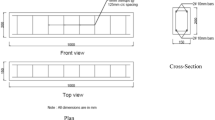Abstract
Ordinary concrete beams (shear span–depth (a/d) ratio > 2) often used in mega and small structures, while deep beams (a/d ratio < 2) are designed for some architectural purposes. Limited researches on the behavior of fiber-reinforced concrete (FRC) using only steel fibers are available to assess the effect of a/d ratio. This study investigates the flexural capacity and load–displacement behavior of polyvinyl alcohol FRC (PVA-FRC) ordinary and deep beams by varying a/d ratio. In 02 mix types, plain and containing metakaolin as 10% cement replacement, up to 3% volume fraction of PVA fibers added by volume of concrete. Using each mix, 03 beams of each of the size as 100 × 200 × 1500 mm, 100 × 200 × 700 mm, and 100 × 200 × 500 mm cast and tested to failure under third-point loading using a/d ratio as 3.5, 1.5, and 1.0, respectively. The test results showed a significant effect of a/d ratio on the flexural capacity; however, the deflection-hardening response is independent. Besides, an analytical expression to predict the flexural strength based on a/d ratio proposed, which is validated through finite element analysis (FEA). The experimental flexural strengths confirmed the results obtained from the analytical model and FEA, whereas the FEA results also endorsed load–displacement behaviors of PVA-FRC.



















Similar content being viewed by others
References
426, A-AC (1973) The shear strength of reinforced concrete members. J Struct Div ASCE 99(ST6):1148–1157
ACI Committee 363 (1992) State-of-the-art report on high-strength concrete. In: ACI 363R-92. ACI
Ahmed M, Mallick J, Hasan MA (2016) A study of factors affecting the flexural tensile strength of concrete. J King Saud Univ Eng Sci 28(2):147–156
ASTM, C (2010) Standard test method for flexural strength of concrete (using simple beam with third-point loading). In: American society for testing and materials
ASTM, I (2010) Standard test method for flexural performance of fiber-reinforced concrete (using beam with third-point loading), United States
Ayub T, Khan SU (2017) Finite element modelling of FRC beams containing PVA and basalt fibres: a comparative study. In: AIP conference proceedings. AIP Publishing LLC
Ayub T, Khan SU, Shafiq N (2018) Flexural modelling and finite element analysis of FRC beams reinforced with PVA and basalt fibres and their validation. Adv Civ Eng. https://doi.org/10.1155/2018/8060852
Ayub T, Khan SU, Ayub A (2019) Analytical model for the compressive stress–strain behavior of PVA-FRC. Constr Build Mater 214:581–593
Bažant ZP, Oh BH (1983) Crack band theory for fracture of concrete. Matériaux et construction 16(3):155–177
Bresler B, MacGregor JG (1967) Review of concrete beams failing in shear. J Struct Div 93(1):343–372
C494, A (2004) Standard specification for chemical admixtures for concrete. ASTM International, West Conshohocken
C143/C143M-15a, A (2015) Standard test method for slump of hydraulic-cement concrete. ASTM International, West Conshohocken
C192, A (2007) Standard practice for making and curing concrete test specimens in the laboratory. Annual Book of American Society for Testing Materials Standards, 4
Carpinteri A (1989) Decrease of apparent tensile and bending strength with specimen size: two different explanations based on fracture mechanics. Int J Solids Struct 25(4):407–429
Cervera M, Chiumenti M (2006) Smeared crack approach: back to the original track. Int J Numer Anal Methods Geomech 30(12):1173–1199
Cervenka V, Jendele L, Cervenka J (2007) ATENA program documentation part 1 theory. Cervenka Consulting, Prague, p 231
Guan Q, Zhang P, Xie X (2013) Flexural behavior of steel fiber reinforced high-strength concrete beams. Res J Appl Sci Eng Technol 6(1):1–6
Holschemacher K, Höer S (2008) Influence of PVA fibers on load carrying capacity of concrete with coarse aggregates. In: Seventh international Rilem symposium on fibre reinforced concrete: design and applications
Institute, AC (2008) ACI 238.1R-08. In: Report on measurements of workability and rheology of fresh concrete. ACI, Farmington Hills
Kani GNJ (1964) The riddle of shear failure and its solution. In: ACI journal proceedings. ACI
Kani GNJ (1967) How safe are our large reinforced concrete beams? J Proc 64(3):128–141
Khan SU, Ayub T (2016) Modelling of the pre and post-cracking response of the PVA fibre reinforced concrete subjected to direct tension. Constr Build Mater 120:540–557
Khan SU, Ayub T, Rafeeqi SFA (2013) Prediction of compressive strength of plain concrete confined with ferrocement using artificial neural network (ANN) and comparison with existing mathematical models. Am J Civ Eng Architect 1(1):7
Meng D, Zhang Y, Lee C (2017) Numerical study on flexural behavior of steel reinforced polyvinyl alcohol-engineered cementitious composite beams. In: 9th Australasian congress on applied mechanics (ACAM9), Engineers Australia
Naik U, Kute S (2013) Span-to-depth ratio effect on shear strength of steel fiber-reinforced high-strength concrete deep beams using ANN model. Int J Adv Struct Eng 5(1):29
Neville A, Aitcin P-C (1998) High performance concrete—an overview. Mater Struct 31(2):111
Novak D, Bazant ZP, Vitek JL (2002) Experimental-analytical size-dependent prediction of modulus of rupture of concrete. In: Bilek V, Kersner Z (eds) Non-traditional cement and concrete, pp 387–393
Nuruddin MF, Khan SU, Shafiq N, Ayub T (2014) Strength development of high-strength ductile concrete incorporating Metakaolin and PVA fibers. Sci World J. https://doi.org/10.1155/2014/387259
Nuruddin MF et al (2015) Strength prediction models for PVA fiber-reinforced high-strength concrete. J Mater Civ Eng 27(12):04015034
Rafeeqi SFA, Ayub T (2013) Behavior of reinforced concrete beams detailed for shear in compliance with compressive force path method. NED Univ J Res 10(1):13–31
Redon C et al (2001) Measuring and modifying interface properties of PVA fibers in ECC matrix. J Mater Civ Eng 13(6):399–406
Sanal I (2019) Effect of shear span-to-depth ratio on mechanical performance and cracking behavior of high strength steel fiber-reinforced concrete beams without conventional reinforcement. Mech Adv Mater Struct 1–16
Shafiq N et al (2015) Calcined kaolin as cement replacing material and its use in high strength concrete. Constr Build Mater 81:313–323
Shafiq N, Ayub T, Khan SU (2016a) Investigating the performance of PVA and basalt fibre reinforced beams subjected to flexural action. Compos Struct 153:30–41
Shafiq N, Ayub T, Khan SU (2016b) 3D nonlinear finite element analysis of HPFRC beams containing PVA fibers. In: Engineering challenges for sustainable future: proceedings of the 3rd international conference on civil, offshore and environmental engineering (ICCOEE 2016, Malaysia, 15–17 Aug 2016). CRC Press
Soranakom C, Mobasher B (2007) Flexural modeling of strain softening and strain hardening fiber reinforced concrete. In: Proceeding of the fifth international RILEM workshop, high performance fiber reinforced cement composites (HPFRCC5)
Wight JK, Macgregor JG (2009) Reinforced concrete mechanics and design. Vol. 4. Pearson Education Inc, Upper Saddle River
Yuan F, Pan J, Wu Y (2014) Numerical study on flexural behaviors of steel reinforced engineered cementitious composite (ECC) and ECC/concrete composite beams. Sci China Technol Sci 57(3):637–645
Funding
This study is conducted in support of NED University of Engineering and Technology and its staff. There was no funding available for this study.
Author information
Authors and Affiliations
Corresponding author
Ethics declarations
Conflict of interest
The authors had not received any research grants whatsoever for this study. The authors declare that they have no conflict of interest.
Ethical Approval
This article does not contain any studies with human participants or animals performed by any of the authors.
Rights and permissions
About this article
Cite this article
Ayub, T., Khan, S.U. Flexural Investigation of a/d Ratio for High-Strength PVA-FRC Beams Based on Experimental and Finite Element Analysis. Iran J Sci Technol Trans Civ Eng 46, 717–732 (2022). https://doi.org/10.1007/s40996-020-00544-0
Received:
Accepted:
Published:
Issue Date:
DOI: https://doi.org/10.1007/s40996-020-00544-0




